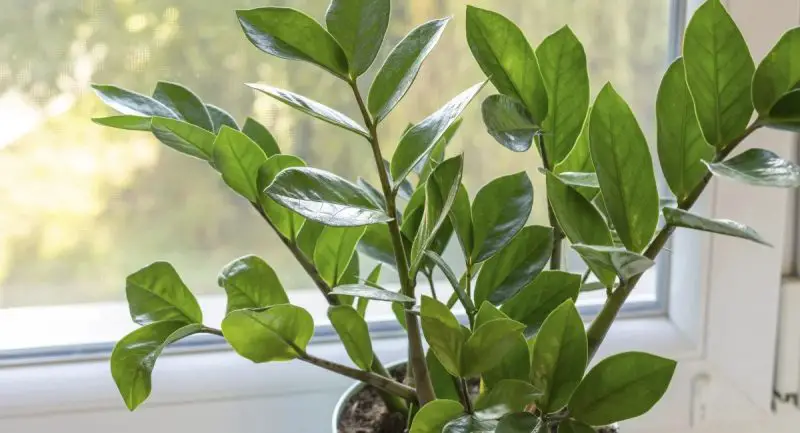Understanding how much light a ZZ plant needs is the key to keeping its leaves green, glossy and strong. Many growers believe the plant thrives in darkness because it tolerates low-light corners so well. Yet the plant still follows natural light rhythms shaped by its native environment. When you match those rhythms indoors, the plant reveals its true potential. Light intensity influences how quickly the leaves develop, how firm the stems remain and how vibrant the plant’s color becomes. With the right lighting, the plant grows confidently and maintains its elegant shine.
Every home provides a different lighting environment, and the ZZ plant reacts to these differences with surprising sensitivity. Rooms with bright indirect light help the plant produce rich pigments that deepen its glossy appearance. Dim rooms slow the plant’s metabolic activity and stretch its stems. Direct sun causes stress because the leaves were not built to handle harsh rays. The secret lies in finding the balance that encourages stable growth without causing damage. When you understand how light shapes the plant’s behavior, you can adjust placement easily. This awareness helps you create the perfect space for long-term beauty.
Understanding the Light Needs of a ZZ Plant

The ZZ plant has evolved to handle a wide range of lighting conditions, but its ideal environment sits between low light and bright indirect light. In nature, the plant grows beneath taller vegetation where sunlight filters through the canopy. This creates a soft, diffused brightness rather than harsh rays. Indoors, the plant responds best to similar conditions. When placed in a spot with consistent but gentle light, the leaves develop strong pigments that deepen their glossy sheen. This balance helps the plant grow steadily and maintain firm stems without stretching.
Although the plant tolerates low-light areas, long-term darkness slows its internal processes. The rhizomes release energy more slowly and produce fewer new shoots. Stems may grow thin as they reach toward any available brightness. Leaves lose some of their natural shine because reduced light limits pigment production. Low light does not harm the plant immediately, but it influences appearance over time. The plant becomes less vibrant when it receives too little illumination. Understanding these subtle shifts helps you adjust the plant’s placement before it loses vigor.
Bright indirect light creates the most favorable conditions for strong, glossy growth. It provides enough energy to support new shoots without causing leaf burn. When the plant receives this level of illumination daily, its leaves stay thick and glossy. The stems remain sturdy and upright, and new growth emerges more frequently. Bright but diffused light also improves color depth, giving the foliage a rich appearance. Once you understand how different light levels influence the plant’s behavior, you can find an ideal location that supports beauty and long-term strength.
How Different Light Levels Affect ZZ Plant Growth
Light levels change the way a ZZ plant grows and how quickly it develops new foliage. When the plant receives bright indirect light, its leaves form with better structure and richer color. The chlorophyll inside each leaflet becomes more active, producing deeper green tones. Stems grow upright because the plant does not need to lean toward stronger light. This environment supports steady, confident growth. The plant maintains a firm posture and releases new shoots at a predictable pace. Bright indirect light allows the plant to show its healthiest form.
Medium light offers a balanced environment, but growth becomes slightly slower. The plant still produces new leaves, yet the stems may not be as thick or firm. The glossy surface remains visible, although color intensity may soften. Medium light keeps the plant stable and healthy, but it does not push the plant toward faster growth. If the plant begins to stretch or lean, it signals that the light level is dropping. Adjusting the plant’s distance from the window often restores its balance and prevents weak or elongated stems.
Low light conditions reveal the plant’s adaptability but also its limitations. The plant survives well, yet its growth slows significantly. Stems extend toward available brightness, creating a more spaced and less compact appearance. The leaves grow thinner and lose some of their glossy shine because they receive less energy. Low light reduces pigment formation and weakens the plant’s structure over time. Although the plant remains alive, it cannot reach its full potential in dim spaces. Understanding how each light level shapes the plant helps you place it where beauty and health are both supported.
Finding the Best Spot in Your Home for Maximum Gloss and Color
Finding the ideal location for your ZZ plant begins with observing how light moves through your home during the day. Rooms with bright indirect light offer the plant the perfect balance between energy and protection. East-facing windows provide gentle morning sun that strengthens pigment production without damaging the leaves. North-facing windows give a soft, consistent brightness that supports slow but steady growth. When the plant receives this type of filtered illumination, it maintains strong leaf texture and a richer green tone. This placement keeps the plant healthy without exposing it to harsh rays.
South- or west-facing windows provide stronger sunlight, so distance becomes important. Placing the plant several feet away from these windows protects it from direct beams that may burn its leaves. The glossy surface of the foliage reflects some light, but prolonged exposure still causes stress. A sheer curtain helps soften the intensity and creates a safe lighting environment. When the plant sits in the right spot near these brighter windows, it receives enough energy for strong growth while avoiding leaf damage. Observing the plant’s response over several days helps you fine-tune the placement.
Interior spaces can also work well if the light remains consistent throughout the day. A location near an open doorway or across the room from a bright window provides gentle illumination. Rotating the plant every two weeks ensures the stems grow evenly and prevents leaning. If the plant starts stretching toward one side, the light is likely too weak. Adjusting the angle or moving the pot slightly closer to brightness usually resolves the issue. With the right spot, the plant maintains its glossy shine, firm structure and deep green color throughout the year.
Why Bright Indirect Light Keeps ZZ Plant Leaves Glossy
Bright indirect light activates the pigments that give ZZ plant leaves their deep green color and natural shine. When the plant receives steady, diffused brightness, chlorophyll production increases. This process strengthens each leaflet and improves surface texture. The glossy appearance comes from healthy cell structure supported by balanced energy. Bright indirect light also keeps stems firm because the plant has enough power to maintain strong growth. This level of illumination mirrors the plant’s natural habitat, where sunlight filters through taller vegetation rather than hitting the leaves directly.
Too much direct sunlight disrupts this balance. Harsh rays overwhelm the plant’s protective layers and cause leaf burn. Burned patches lose their shine and turn pale or rusty. The glossy surface cannot recover quickly from this damage. Even short periods of direct afternoon light may weaken pigment formation. When brightness becomes intense, the plant closes its leaf pores to reduce stress, slowing growth and lowering energy production. Avoiding direct exposure helps maintain the smooth, polished appearance that makes the plant attractive.
Bright indirect light also improves nutrient movement inside the plant. When energy levels remain stable, the rhizomes release stored resources more efficiently. New shoots appear more vibrant because they develop under ideal lighting conditions from the beginning. This prevents thin, dull or yellowish growth. Over time the plant becomes fuller, healthier and noticeably more radiant. Leaves remain thick and shiny, and stems stay upright. Maintaining this gentle brightness ensures long-lasting beauty and keeps the plant thriving in a wide range of indoor settings.
How Low Light Changes the Shape, Color and Strength of Your ZZ Plant
Low light affects the ZZ plant more slowly than many houseplants, but the changes become clear over time. When the plant receives minimal illumination, it begins to stretch toward the nearest brightness. This stretching creates longer, thinner stems that lean instead of standing upright. The plant uses extra energy to reach light rather than building firm tissue. As a result, the overall form becomes loose and less symmetrical. While the plant survives, it cannot maintain the compact, sturdy posture that bright indirect light naturally supports.
Color also fades in prolonged low-light conditions. Without enough energy, the plant produces less chlorophyll, the pigment responsible for its deep green shade. The leaves begin to look duller because the surface loses some of its reflective quality. Glossiness decreases as the plant diverts energy away from leaf texture and toward basic survival. In very dim spots, new growth may appear pale or slightly yellowish. This is not a sign of disease but rather a response to insufficient light. Adjusting the plant’s location often restores its vivid color within several weeks.
Low light also influences long-term strength. The rhizomes store moisture and nutrients, but they rely on light to replenish that energy. When light remains too weak, the rhizomes slow their activity. New shoots form less frequently, and older stems weaken. The plant becomes sensitive to environmental changes because its reserves diminish over time. Improving light exposure helps rebuild internal strength and returns the plant to a stable rhythm. Even a modest increase in brightness can restore firmness and stimulate healthier growth. Understanding these effects helps you correct lighting issues before they become long-term problems.
The Effects of Direct Sunlight and How to Prevent Leaf Damage
Direct sunlight affects the ZZ plant more intensely than many growers expect. The smooth, waxy leaves appear strong, yet they are sensitive to harsh rays. When exposed to direct sun, especially during midday or afternoon, the leaf surface heats quickly. This causes tissue stress that leads to pale spots, crisp edges or patchy burn marks. These marks do not recover because the damaged cells cannot rebuild their pigment. Over time the glossy surface becomes uneven, and the plant loses its refined appearance. Even a few hours of strong sun can create lasting marks.
Direct sunlight also disrupts the plant’s internal rhythm. When the leaves overheat, the plant closes its stomata to prevent moisture loss. This slows photosynthesis and reduces energy production. The plant enters a protective mode rather than a growth mode. Stems may stiffen or lean away from the light source as the plant attempts to avoid harm. New growth emerging during sun stress often appears smaller or thinner. Continuous exposure to harsh rays weakens the rhizomes because they cannot support strong growth under these conditions.
Preventing leaf damage requires strategic placement. Moving the plant several feet away from a bright window often solves the issue. Sheer curtains soften intense light and reduce glare while still providing enough brightness for healthy development. If the plant sits on a windowsill, shifting it to a nearby table shields it from direct beams. Rotating the pot every two weeks keeps all stems growing evenly. Once harsh light is controlled, the plant gradually recovers its glossy texture. New leaves form with stronger pigment and healthier structure, restoring the plant’s appearance and overall vitality.
How Artificial Light Can Support Healthy ZZ Plant Growth
Artificial light becomes a valuable support system when natural light is limited. Many indoor spaces receive uneven lighting throughout the day, and ZZ plants respond well to stable brightness from artificial sources. LED grow lights provide a balanced spectrum that mimics natural daylight without producing excessive heat. When placed at a safe distance, they deliver consistent illumination that keeps leaves firm and glossy. This steady brightness helps maintain photosynthesis during darker months or in rooms with few windows. Under artificial light, the plant builds stronger stems and produces healthier new shoots.
Not all artificial lights offer the same benefits. Warm household bulbs create a pleasant ambiance but do not deliver enough energy for active plant growth. Fluorescent bulbs provide better brightness but may create uneven coverage depending on placement. Full-spectrum LED lights remain the most effective choice because they supply the wavelengths that support chlorophyll production. Positioning the light about one to two feet above the plant usually provides the ideal intensity. Too much light may cause slight leaf fading, while too little slows the plant’s energy cycle. Adjusting the height ensures a balanced and comfortable environment.
Artificial light becomes especially useful in winter when natural light drops. Shorter days reduce sunlight hours, and the plant may slow its growth rhythm. Turning on artificial lights for several hours a day compensates for this loss and keeps the plant stable. Timers help create a predictable pattern that mirrors daylight cycles. As consistency improves, the leaves maintain their vibrant tone, and the plant avoids stretching toward limited natural brightness. With proper artificial lighting, the ZZ plant grows confidently even in challenging indoor conditions, maintaining its glossy texture and strong structure year-round.
Signs Your ZZ Plant Is Receiving the Right Amount of Light
A ZZ plant shows clear and reliable signs when it receives the perfect amount of light. The most obvious indicator is the leaf color. When lighting conditions are ideal, the leaves maintain a deep green tone with a natural glossy sheen. This shine forms when chlorophyll production remains strong and steady. Stems also stay firm and upright because the plant does not need to lean or stretch toward brightness. New shoots appear at a consistent pace, unfolding into thick leaflets that develop evenly. These patterns show that the plant has enough energy to support healthy growth without entering a survival mode.
The texture and structure of the foliage offer additional clues. In proper lighting, each leaflet grows smooth, plump and well-shaped. The spacing between leaflets remains even, creating a clean and orderly appearance. There is no curling, wrinkling or thinning along the leaves. The plant also maintains moisture well because it balances energy use with hydration. When the lighting matches the plant’s needs, the rhizomes distribute nutrients efficiently. This results in stable, confident growth instead of slow or irregular development. Leaves remain firm to the touch, showing the plant is neither stressed nor overheated.
Balance in the plant’s overall form confirms that light levels are correct. A ZZ plant exposed to proper brightness grows symmetrically from all sides, with no leaning stems or uneven layering. Rotation becomes optional, not essential, because the plant already receives light from the right angles. Growth remains compact and controlled rather than stretched or sparse. Even new shoots emerge from the soil at regular intervals, proving the rhizomes feel supported. When all these signs appear together, you know the plant is receiving optimal light and will continue thriving with vibrant, glossy foliage year-round.
Symptoms of Poor Lighting and How to Fix Them
Poor lighting influences a ZZ plant slowly, but the symptoms become clear once you understand what to look for. One of the earliest signs is stem elongation. When the plant receives insufficient brightness, it stretches toward the nearest source of light, creating long and thin stems. These stems lose their natural firmness and sometimes bend under their own weight. Leaves may grow farther apart, giving the plant a sparse look instead of its usual compact structure. These changes signal that the plant is working harder than normal to capture energy.
Color changes provide another strong clue. In low light, leaves begin to fade as chlorophyll production slows. The glossy sheen becomes dull, and new growth may appear pale or slightly yellow. If poor lighting continues, older leaves may wrinkle or curl inward. This is not caused by dryness alone but by the plant’s inability to maintain healthy tissue without enough light. The rhizomes slow their energy release and save resources, reducing the plant’s overall vitality. These visual shifts reflect a lighting problem that needs correction.
Improving lighting begins with relocation. Moving the plant closer to a bright window often restores its appearance within several weeks. Bright indirect light allows stretched stems to regain strength as new shoots develop. If natural light is limited, artificial lighting becomes a helpful supplement. A full-spectrum LED placed at the correct distance provides steady brightness without overheating the leaves. Once the plant receives consistent light, color deepens, stems grow more compact and new growth appears healthier. Adjusting placement steadily rather than abruptly helps the plant adapt gently and regain its rhythm.
How to Adjust Light Levels Safely for Faster Improvement
Adjusting light levels for a ZZ plant requires a gentle and gradual approach. Sudden changes in brightness can shock the plant, especially if it has been living in low light for a long period. When moving it closer to a brighter window, start by shifting the pot a short distance every few days. This slow transition helps the leaves adapt without overheating. Bright indirect light provides the energy needed for deeper color, stronger stems and healthier new shoots. A steady adjustment prevents stress and supports smoother recovery.
Monitoring the plant’s reaction during this transition is essential. If the leaves begin to show pale patches or slight curling, the new light may be too strong. Moving the plant back slightly or adding a sheer curtain helps soften the brightness. When the plant receives the right balance, it begins to form new leaves with stronger pigmentation. Existing stems also regain firmness as energy production increases. This process may take a few weeks, but the results become clear as the plant settles into its new lighting rhythm.
Artificial lighting can also help with controlled adjustments. A full-spectrum LED provides measured brightness without sudden intensity changes. Positioning the light at a safe distance maintains consistent illumination and prevents overheating. Adjusting the height or duration of the light session allows you to fine-tune the brightness level. This method is especially useful in winter or in rooms with limited windows. When natural and artificial light work together, the ZZ plant recovers more quickly, regains its glossy finish and maintains strong, balanced growth throughout the year.
How Light Influences Watering, Growth Speed and Overall Health
Light plays a powerful role in shaping your ZZ plant’s growth rhythm. When the plant receives bright indirect light, it uses energy more efficiently and grows at a steady pace. This increased activity speeds up moisture evaporation from the soil. As a result, the plant needs watering slightly more often because it processes water faster. In dim rooms, the plant’s metabolism slows, and the soil stays wet longer. This means watering must become less frequent. Understanding this link prevents both underwatering and overwatering and helps keep the plant healthy.
Growth speed also depends on light intensity. With consistent brightness, the ZZ plant produces new shoots more frequently. These shoots grow thicker and develop richer color because the plant has enough energy to support strong tissue formation. In low light, new growth appears less often and may look thin or pale. The plant enters a preservation mode to save energy. Although it survives, it cannot reach its full potential. Balanced, gentle light ensures the plant grows confidently and maintains an attractive shape over time.
Light also influences overall health by supporting better nutrient movement. Under proper brightness, the rhizomes release stored energy at a steady rate, helping the plant resist stress. Good lighting strengthens the plant’s natural defenses against temperature shifts and minor watering mistakes. Leaves stay glossy because pigment production remains active. When light remains stable, the plant becomes more resilient and displays consistent coloration and structure. Proper lighting forms the foundation for every other aspect of care, helping the ZZ plant thrive in almost any indoor environment.
Seasonal Light Changes and How They Affect Your ZZ Plant
Seasonal shifts change the way light enters your home, and your ZZ plant adjusts its growth rhythm accordingly. During spring and summer, daylight becomes brighter and lasts longer. This increased brightness supports faster photosynthesis and encourages new shoots to form more often. The plant thickens its leaves and strengthens its stems as it receives consistent indirect light. Because energy production rises, the soil dries more quickly, and the watering rhythm becomes slightly more frequent. This seasonal boost allows the plant to grow with confidence and maintain a glossy appearance.
Autumn brings shorter days and softer light. As brightness declines, the plant gradually slows its growth. Stems may appear slightly thinner, and new shoots emerge less frequently. The soil stays moist for longer because the plant uses less water. During this period, adjusting the plant’s placement becomes important. Moving it a little closer to a bright window helps maintain steady leaf color and prevents stretching. Gentle environmental support allows the plant to transition smoothly into the cooler months while preserving its overall health.
Winter creates the most dramatic lighting change. Days become short, windows provide weaker illumination, and many rooms remain dim for long hours. Under these conditions, the plant’s metabolism slows significantly. The plant does not suffer, but it enters a resting phase. Growth nearly stops, and the glossy finish may soften slightly. Artificial light becomes very helpful during this time because it restores energy the plant would otherwise lose. When lighting remains consistent throughout winter, the plant maintains its strength and prepares for a fresh burst of growth when spring returns.
FAQs About How Much Light a ZZ Plant Needs
How do I know if my ZZ plant gets enough light?
A ZZ plant receiving enough light will grow upright stems, deep green leaves and maintain a natural glossy surface. New shoots appear steadily, and the plant keeps a compact shape rather than stretching. If color stays rich and the plant looks balanced from all angles, lighting conditions are correct.
Can a ZZ plant live in a windowless room?
A ZZ plant can survive in a windowless room if given artificial light. A full-spectrum LED placed at a safe distance supplies the energy the plant lacks. Consistent daily brightness prevents stretching, fading and slow growth. Without supplemental lighting, the plant weakens over time and loses its glossy appearance.
Why does my ZZ plant lean toward one side?
Leaning usually means the plant receives uneven light. Stems stretch toward the brightest area to capture energy. Rotating the pot every two weeks helps maintain even growth. Moving the plant closer to bright indirect light or using supplemental LED lighting restores symmetry and strengthens new shoots.
Will direct sunlight help my ZZ plant grow faster?
Direct sunlight does not help growth and may damage the leaves. Harsh rays cause pale burn patches, dry edges and permanent texture loss. Bright indirect light is far safer and allows the plant to build healthy pigments. Consistent filtered brightness produces stronger stems and a richer, glossy leaf surface.
How long does it take for a ZZ plant to recover color after poor lighting?
Recovery depends on light quality and overall plant health. Once placed in bright indirect light, color begins improving within two to four weeks. New growth appears stronger because it develops under better conditions. Older faded leaves will not regain full gloss, but new shoots quickly restore the plant’s vibrant appearance.
Conclusion
Caring for your ZZ plant becomes much easier when you understand how lighting shapes every part of its growth. The right balance of bright, indirect light keeps the leaves glossy, prevents stretching and supports steady new shoots. By adjusting placement with the seasons and correcting low-light symptoms early, you help the plant maintain long-term strength. Consistent lighting allows the ZZ plant to reveal its richest color and most vibrant form, making it a reliable and striking addition to any indoor space.






